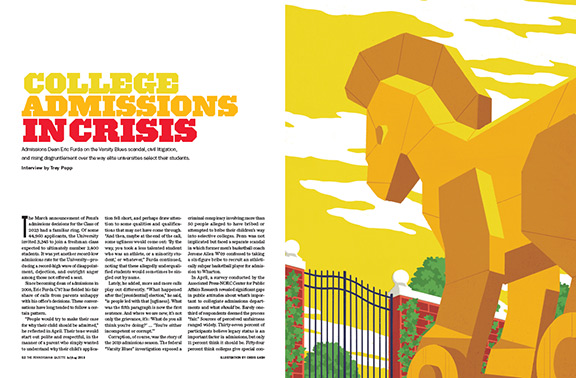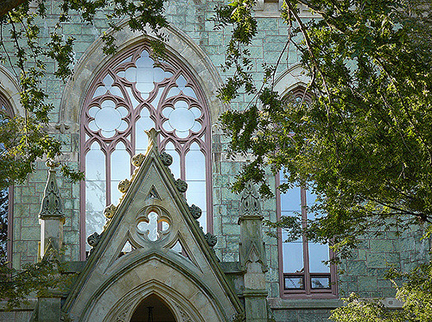
Admissions Dean Eric Furda on the Varsity Blues scandal, civil litigation, and rising disgruntlement over the way elite universities select their students.
Interview by Trey Popp | Illustration by Chris Gash

The March announcement of Penn’s admissions decisions for the Class of 2023 had a familiar ring. Of some 44,960 applicants, the University invited 3,345 to join a freshman class expected to ultimately number 2,400 students. It was yet another record-low admissions rate for the University—producing a record-high wave of disappointment, dejection, and outright anger among those not offered a seat.
Since becoming dean of admissions in 2008, Eric Furda C’87 has fielded his fair share of calls from parents unhappy with his office’s decisions. These conversations have long tended to follow a certain pattern.
“People would try to make their case for why their child should be admitted,” he reflected in April. Their tone would start out polite and respectful, in the manner of a parent who simply wanted to understand why their child’s application fell short, and perhaps draw attention to some qualities and qualifications that may not have come through. “And then, maybe at the end of the call, some ugliness would come out: ‘By the way, you took a less talented student who was an athlete, or a minority student,’ or whatever,” Furda continued, noting that these allegedly underqualified students would sometimes be singled out by name.
Lately, he added, more and more calls play out differently. “What happened after the [presidential] election,” he said, “is people led with that [ugliness].
What was the fifth paragraph is now the first sentence. And where we are now, it’s not only the grievance, it’s: ‘What do you all think you’re doing?’ … ‘You’re either incompetent or corrupt.’”
Corruption, of course, was the story of the 2019 admissions season. The federal “Varsity Blues” investigation exposed a criminal conspiracy involving more than 50 people alleged to have bribed or attempted to bribe their children’s way into selective colleges. Penn was not implicated but faced a separate scandal in which former men’s basketball coach Jerome Allen W’09 confessed to taking a six-figure bribe to recruit an athletically subpar basketball player for admission to Wharton.
In April, a survey conducted by the Associated Press-NORC Center for Public Affairs Research revealed significant gaps in public attitudes about what’s important to collegiate admissions departments and what should be. Barely one-third of respondents deemed the process “fair.” Sources of perceived unfairness ranged widely. Thirty-seven percent of participants believe legacy status is an important factor in admissions, but only 11 percent think it should be. Fifty-four percent think colleges give special consideration to varsity athletes, but only 32 percent think that should be a big factor. Forty percent of participants think colleges emphasize racial background to assure diversity, but only 27 percent think they should—the same percentage that think gender should be taken into account to ensure even numbers of male and female undergraduates.
Furda has a penchant for the long view. “Over the history of this institution, but even more so during the last 50 years—so you can go back to the civil rights movement—Penn has gone from a local institution, to a regional one, to national, to international. And this is always seen as zero-sum in trade-offs: if this person’s in, and I’m not, they took ‘my seat.’ And that’s the tenor of where we are right now.’”
In April he sat down with Gazette senior editor Trey Popp to discuss the current state of college admissions, and what may loom ahead. Their conversation has been edited for length and clarity.
There’s been some experimentation in recent years in college admissions. Last year the University of Chicago stopped requiring applicants to submit SAT or ACT scores. And Princeton added a component to its application asking students to submit a graded high school paper. Do any of those ideas—or any others you’ve come across lately—merit consideration or adoption at Penn?
I think they all deserve consideration. There’s a litmus test that I have for anything. One is: What are you asking a student to do? And is that a barrier? The second is: What are we going to ask our admissions officers to actually read? I’m perfectly fine adding something—if we’re going to evaluate it. But otherwise we’re just throwing something else in the mix. For example, we really prioritize the alumni interview as something that we feel has valid input into our process—an opportunity for a student to have a conversation. That takes volunteer time, and that takes a student time. We’re asking that, though, because we’re going to read those reports.
Last October a federal district court heard arguments in Students for Fair Admissions v. Harvard, where the plaintiffs alleged that Harvard is discriminating against Asian American applicants by dint of the fact that their “holistic admissions process” includes race or ethnicity as one of a large number of factors that they consider. The court has not decided anything yet. Penn joined an amicus brief in support of Harvard. Can you talk about what’s at stake in that case and how its outcome could potentially affect the way Penn admits its students?
I think everything’s at stake. Even beyond some type of institutional ability to make decisions and the processes in order to make those decisions, there is a fundamental disagreement in this country about what we’re really trying to achieve.
What’s at stake is twofold. One is what do we value in admitting a class—and whether people agree with those values or not. Affirmative action, legacy, athletics, first-generation: it’s like you can sometimes agree with one of them—until it starts feeling like it’s impinging on ‘my seat’ in the class, as though there’s a reservation on it. So the first part of this is the process and the priorities that we have, and whether people agree with them or not. And by and large people don’t agree with what we’re doing.
What we’re trying to achieve, and we feel very strongly about it, is that here’s a four-year period where students are going to be able to learn from difference. That students are going to be able to learn from people who think differently, have different backgrounds, different contexts. Maybe they look different; maybe they don’t. But let’s not even say that those kids that look alike have the same lived experiences, as well!
So what’s at stake is, first, our ability to actually carry out the work that we do on a daily basis, and second, the type of experiences that we want students to have in a learning residential community.
In January a number of Senate Democrats sent letters to higher education experts asking for ideas about how to narrow racial and ethnic gaps in student debt and access to college. What role, if any, do you think US legislators should have in shaping the standards for admissions at private universities—or state-run public ones?
Well, what’s interesting here is they’re trying to close the gaps on some things that we’re trying to close gaps on, but people are disagreeing about how to do it. So you can have a legislator say we want to decrease racial and socioeconomic gaps, while the courts are deciding whether we can consider race.
I do think that there’s a responsibility and role that private institutions have, public institutions have, and our public officials have. I don’t think any one should say, ‘This is our domain only.’ I think we have to agree on what are the larger priorities and values that we have, how we actually get that work done. And we need guidance on that, too, making sure that we’re not breaking the law. It usually just comes through civil rights— making sure that we’re approaching this in a manner that is beneficial to achieve the outcomes that we want to have, and not do unnecessary harm.
I do get concerned. If we’re going through trying to check off every single box of how to do something, we’re not going to be able to do our work.
If you can depoliticize it, and actually have the “spirit of compromise,” as one of Dr. Gutmann’s books says, we can balance this in a rational way. Unfortunately we are not living in a time when each side of the aisle will even come together on anything. So do I agree that there’s a role? Yes. Do I think that we’re presently in a place where that can happen? No.
A group called New America has proposed that colleges that incorporate a legacy preference for children of alumni should lose access to federal aid programs. If such a policy actually came to pass, how would it impact Penn? The University has a huge financial aid budget that it mounts on a private basis. But if somebody were to use federal aid programs as a cudgel, how threatening would that be?
It’s very threatening. There’s an interaction between all of these funding sources: tuition and fees, payoff on endowment, fundraising, and federal money, or any type of support—foundation, government money. If you completely do away with one, it’s going to impact another. And it’s going to have an impact on the students who apply to your institution, who you could admit, and who’s going to enroll.
We know what the impact would be, going back to the Harvard case, if affirmative action is no longer legal in this country—if the Supreme Court decides that. If you say that legacy should not be considered, for the most part as long as grades and test scores matter we’re going to get a lot of our legacies right there. So then you could say, ‘Well, then why do it anyway?’ Because we are sending a signal to our customers—and I don’t know any other business that doesn’t value its customers. And their support does help support our large financial aid policies through fundraising and through other ways.
Also, we’ve been around long enough to know that, in the late ’70s, children of our alumni were not applying to Penn. And now that they are, we still want to have our loyal base here.
The biggest college admissions story this year has been the federal prosecution of 50-some-odd people on criminal conspiracy charges for bribing, or attempting to bribe, their children’s way into college. Penn wasn’t involved in Operation Varsity Blues; but former basketball coach Jerome Allen testified in federal court that he had received hundreds of thousands of dollars in bribes to recruit a basketball player who would not have otherwise made the team, in his judgment, resulting in that young man’s acceptance to Wharton. These cases are still being litigated, which I suspect limits your ability to comment on them. But they illuminated a corner of college admissions that many people are not all that familiar with, which is the influence athletic teams can exert on admissions decisions. And I wanted to just step back from that a bit to ask you a more general philosophical question: What is the purpose of collegiate athletics?
There is a gap between whether people feel that special talent in a sport is important. [In the AP poll] 54 percent of people said that they feel that sports recruitment is important in our decision-making, while 32 percent feel that it should have an impact in admissions decisions.
What’s interesting is that 52 percent think that extracurricular activities in high school are important in our deliberations, whereas 44 percent feel that they should be.
So people like the idea of extracurricular activities but feel that athletes are getting too much of a hand up.
Exactly. But I think a big part of this is that there is no predictability of who’s going to be admitted. If you’re in China and take the national exam, the gaokao, that’s what draws the line: based on your score, you’re going to go to college or you’re not going to go to college. But when we get into more of a comprehensive analysis, where these other factors are taken into consideration—because we want to know where and how students are going to participate, impact a community, be involved—you don’t have that kind of predictability.
There is a community aspect to athletics. And I think that what’s being attacked across the board are those pieces that are community-building and are a part of American higher education. The Ivy model moved away from us filling Franklin Field and playing in the Rose Bowl and playing in national championships. Now, do we need 33 sports teams? Is that too much? We should have those conversations. But my strong belief is, if we have those teams, we should support them. I won one lightweight football game in four years, so I have character beyond my 5-foot-9 frame! Our student athletes should have the facilities, the support in order to compete for an Ivy championship over their four-year period. Are they going to win it always? No. And that’s life. And there’s lessons there. Hopefully other people learn from it—and it’s not just the students who are participating.
Also, the students within the Athletics Department, the type of work that they’re doing around leadership through Wharton, the type of work that they’re doing with Penn Med about truly holistic support of the student athlete, the work that they’re doing on concussion studies with the Big Ten—I mean, we’re a research university. The work that’s coming from the performance of our student athletes at the Division I level has benefits beyond even the participants and whether you want to go to a game or not.
It sounds like you believe in collegiate athletics primarily because of the community-building and leadership development aspects that are inherent in sports and competitive athletics. Is that fair to say?
Absolutely.
So how is that purpose advanced best by identifying potential participants in sports prior to the admissions process, as opposed to waiting until students arrive and populating teams from the people you had accepted?
So we’re talking maybe like a walk-on model for everything? Some sports are more conducive to a walk-on model. We even saw walk-ons in lightweight football, people that never played organized football before coming out and playing. I think that the walk-on model, or even the Division III model, is one that certainly does have its place.
But I’ll bring that back to my 10-year-old son, who plays basketball and baseball. There’s a difference between kind of the neighborhood participation that he was in—where everyone signs up and everyone plays, and that’s fantastic—and the leagues he’s in now among kids who are really excelling. We’re kind of talking like the AP course instead of the regular course. There are some students, some young people, who are prioritizing this. It is what they are. It’s what they want to do, and they’re excelling at it. And for them to be able to do that for 22 years at that level, then the next pieces come in: What does a team look like? You know, all of our work here, it’s about knowing your role as a team member. [Which is something that also matters] in the workplace—you have to know what it means to work collaboratively and as part of a team.
So, last question on this topic: What has Penn learned from the revelations surfaced by the Varsity Blues investigation? Has the University implemented any policy designed to safeguard itself from these kind of abuses in the future?
Unfortunately—I’ll phrase it that way, “unfortunately”—because of the Jerome [Allen] case, we were a little bit ahead of the curve of Varsity Blues. We were already having to look at our processes and our systems and our safeguards and our checks and balances, to make sure that something like this does not happen again.
We need to show that there are repercussions, and that people are probably going to find out about something eventually. And that may deter the vast majority of people who would think of doing something wrong. But there are actors that are going to do whatever they’re going to do, and also try to influence people. Our coaches don’t make that much money. And that’s not condoning them to do something that’s wrong, let alone illegal. But I don’t know what their family circumstances are. And people can be manipulated. I’m not going to throw stones at anybody. That all being said, systematically we need to have checks and balances in place. And I feel that we have improved upon those. But the bottom line here is there is still some implicit trust between our department and the people in those departments.
There’s an idea that’s been batted around the last few years about incorporating lotteries into college admissions decisions. The general thrust is that universities could establish minimum criteria, however they saw fit, and that applicants who met those criteria would be entered into a lottery which would randomly populate the class. Sometimes people advocate this as a way to remove bias. But some proponents also see a benefit in changing the way applicants to elite universities view the circumstance of their admission—that it’s not only something they deserve because of their own effort and merit, but they are in fact beneficiaries of good fortune. After all, if you have 45,000 people applying for 3,000 spots, even if only a half or a quarter of those students have what it takes to thrive at Penn, there’s still a great deal of luck that comes into play in who gets invited and who doesn’t. Every year at Convocation these students are greeted with the message, “You’re the most amazing class that’s ever come to Penn.” So there’s a lot to puff up people’s self-image and sense of entitlement, when in fact there’s also a lot of luck. And so one of the interesting things about this lottery idea is that it would make plain that there is an element of luck in all this, so perhaps you should thank your good fortune—in addition to your parents, and your community, and all the rest. Do you find anything attractive about that idea?
There’s an assumption here that this is a crapshoot and a lottery anyway. They’re downplaying the fact that we have 30-some people here reading these applications, and that we’re having discussions about them.
If you’re saying establish a minimum threshold, now I see kind of the state school chart that says “GPA / Testing.” And if you’re in this zone, you’re in; and if you’re in this zone, you get some financial aid. That’s not how we’re making these decisions. That’s actually going backwards. I don’t think you’re getting the types of communities we actually want to create.
And what’s objective about a 98 percent GPA? Where? What were the courses?
So I just don’t think there would be better outcomes, and I don’t think it’s a better process.
When you looked at these survey results about what people perceive to be important in college admissions versus what they think should be, did it cause you to reexamine any of your own assumptions?
What needs to be reexamined is maybe two pieces. One is: Are the values and goals that we have ones that we should have? And you can say yes or no to that. Then the next question is: Is the way that we’re trying to achieve those goals effective?
It used to be about process up to this point. Now people are just fundamentally disagreeing with what we’re trying to achieve.
Fundamentally people do not believe that building a residential college community with different voices, different learned experiences, different backgrounds is of value. And they’re seeing higher education institutions—especially ones with large endowments and low admit rates—as a great target.
Where it goes, I’m not quite sure. I know that the way that we can conduct our work is becoming increasingly difficult. We are trying to work towards an idea that people will once again come into a community and actually have dialogue with each other. We’re not there. The dialogue is not taking place. And this is one of the last opportunities for it to take place. It’s not going to happen in graduate school, which has a different purpose. And in the workplace, that’s a completely different environment.
We just came off of Quaker Days with our Admitted Student Days. What’s really interesting is you’re sitting or standing at the Palestra, and as admissions officers, we’re starting to see this class come together. Everyone always focuses on the statistics of 50 states, 100 countries, and you know the litany of those statistics. But for us, what we’re trying to achieve is seeing these students actually interact with each other. And again, you could try and quantify individuals by different categories— either for federal reporting categories or legacy or first generation—and of course those all resemble or reflect the priorities of the institution. But for us, it’s not just a categorization of people. It’s the opportunity to actually come together and create community.








